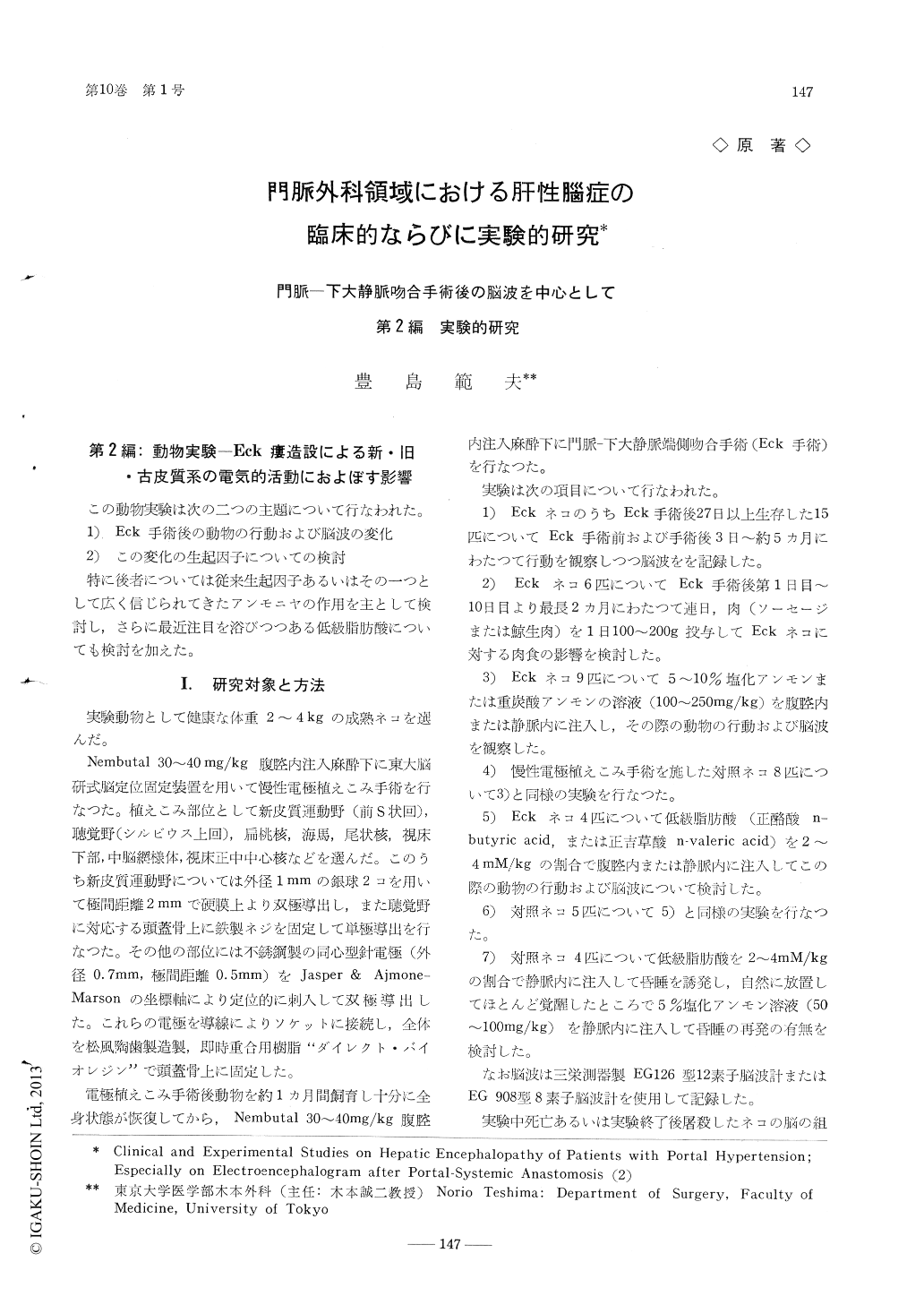Japanese
English
- 有料閲覧
- Abstract 文献概要
- 1ページ目 Look Inside
第2編:動物実験―Eck瘻造設による新・旧・古皮質系の電気的活動におよぼす影響
この動物実験は次の二つの主題について行なわれた。
1)Eck手術後の動物の行動および脳波の変化
Methods and Materials:
For the purpose to clarify the mechanism of hepatic encephalopathy, especially of neuropsychiatric disorder after portal-systemic anastomosis, clinical and experimental investigations were done.
The electroencephalographic studies were carried out on the 69 pre-and/or postoperative patients with portal hypertension.
In order to clarify what the important factorto cause hepatic encephalopathy is, a correlation between the degree of the electroencephalographic changes and the liver function tests, blood lactate, pyruvate, ammonia and short-chain fatty acids levels were also studied.
In the experimental research EEG patternsof the neo-, paleo-, and archicortices and behavioral changes of the 26 cats with chronicallyimplanted electrodes were observed for 1 to 5months. Three or four weeks after the electrode implantation, the end-to-side portacaval anastomosis was done on the 15 cats.
Results:1) Even before the operation about 40% of the 26 patients with portal hypertension showed electroencephalographic abnormalities (slow waves), though these were slight changes in most cases.
2) Much more frequent electroencephalographic abnormalities were seen, which were moderate or marked in 50% of the 43 cases, after the shunt operation, while the frequency of manifest Eck-fistula syndrome was 30%. It indicates that the central nervous system, especially the neocortical system, was fnnctionally impaired after the shunt operation on the basis of the experimental results that the electrical activity level lowered, spindle bursts disappeared and 5 cps spike-and-wave complexes of ten appeared in the neocortical system.
The abnormal EEG patterns were apt to appear after the shunt operation in elders, cirrhotics and patients who had shown abnormal, even though slight, electroencephalographic changes.
3) The interesting 5 cps spike-and-wave activities which appeared spontaneously especially in the drowsy state of the cats with Eck fistula are considered to be equal to the "triphasic wave" in human hepatic encephalopathy.
4) Blood short-chain fatty acids and ammonia levels elevated in the patients who had abnormal electroencephalographic changes. It was demonstrated in the experimental research that short-chain fatty acids act to produce a marked lowering of the electrical activity of the brain, whereas ammonia has no marked comatogenic action upon the brain, but it strengthens the action of the former and elicits the 5 cps spike-and-wave activity in the cats with Eck-fistula.
It is presumed from these findings that short-chain fatty acids are the principle comatogenic factors and ammonia plays assisting role or trigger in hepatic encephalopathy.
5) It is concluded that the indication of theshunt operation for the patients with portalhypertension is to be limited more strictly, on the basis of facts that the high frequencyof appearance of the electroencephalographicabnormality was seen after the shunt operation and the prognosis of the patients whohad undergone the portal-systemic shuntoperation was proved not to be so satisfactory as a three years survival rate was only 54.5%.

Copyright © 1966, Igaku-Shoin Ltd. All rights reserved.


